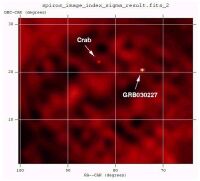Extragalactic
Active Galactic Nuclei
Some galaxies show a very bright light emission coming from the centre of the galaxy, and are, therefore, called active galactic nuclei. There are different types of active nuclei, the most interesting of which for gamma-ray astronomy are the Seyfert galaxies and quasars. They are thought to be one single phenomena of different intensity. The active nucleus of a Seyfert galaxy emits the same amount of energy as does a whole galaxy, while a quasar emits the energy of hundreds of normal galaxies making it very difficult to distinguish the rest of the galaxy.
A quasar seen through a telescope looks like a star, hence its name is a contraction of "quasi-stellar radio source" or just "quasi-star". The prodigious amount of energy released by quasars make them the most powerful objects in the Universe. The fact that they emit in all wavelengths of the electromagnetic spectrum implies highly complex mechanisms. The luminosity of quasars and Seyfert galaxies is attributed to the presence of a super-massive black hole of a million up to a billion solar masses (depending on the luminosity) dragging nearby matter into them, thus forming a huge accretion disk comparable to the disk of interacting binaries.
Another type of active nucleus will also be studied by INTEGRAL. In the illustration on the right, perpendicularly to the accretion disk lies a kind of jet. Such jets, which are easily detected by radio telescopes, are only found around some active nuclei. When a jet points in the direction of the earth, its electromagnetic radiation emission is easily detectable. These objects, called "blazars", emit mainly in the gamma-ray region. INTEGRAL will allow a closer study of the physical characteristics of the jet and will reveal a possible high concentration of positrons.
Gamma-Ray Bursts
 |
|
SPI image of GRB030227 |
The observations at different wavelengths confirmed that the gamma-ray bursts are extremely distant and therefore must be caused by tremendous explosions. On 23 January 1999 there was another exciting event. Using orbiting observatories and ground-based telescopes, astronomers from all over the world tracked the visible glow of a gamma-ray burst while it was still emitting high-energy radiation. They discovered that this burst was the most energetic eruption ever recorded, equal to the radiance of one million galaxies or millions of millions of stars.
 |
|
SPI spectrum of GRB030227 |
